Spooky Tales from Haunted National Parks
- Oops!Something went wrong.Please try again later.
This article originally appeared on Outside
Cemeteries are spooky. Cemeteries tucked into the woods miles from anywhere, like the one I stumbled into one night deep in Great Smoky Mountains National Park, are downright spine-chilling. My headlamp cast uneasy shadows in every direction.
I was backpacking in the Smokies to experience some of the history that the park encapsulates. When it was established in 1940, GSMNP swallowed up several communities, and the ruins of tiny timber towns can still be found. There are at least 150 cemeteries inside the park, according to the book Cemeteries of the Smokies. Some are still kept up by family members, and others are slowly being swallowed up by the forest.
Did I actually see a ghost that night? I sure thought I did, given all of the shadows and the noises coming from the woods around me. I set up my tent a quarter-mile away and barely slept, waking at the faintest sound. No wonder Great Smoky Mountains are littered with ghost stories: tales of witches who snatch children or glowing orbs that appear before the eyes of lost hikers.
As co-host of the National Parks After Dark podcast, Cassie Yahian often looks into such tales. She's unsurprised that a number of people report supernatural events inside our parks.
"'National park' is a relatively new label placed on locations that have largely been around for time immemorial," Yahian told me in an email. "The locations protected under that banner have historied pasts that include indigenous peoples, European settlers, pioneers, and beyond. The land remembers," she said, "and shares those stories ... sometimes through an icy chill or a disembodied whisper."
Here are six of my favorite ghost stories from our national parks. Happy Halloween.
Grand Canyon National Park, Arizona
The Wailing Woman and John Wesley Powell
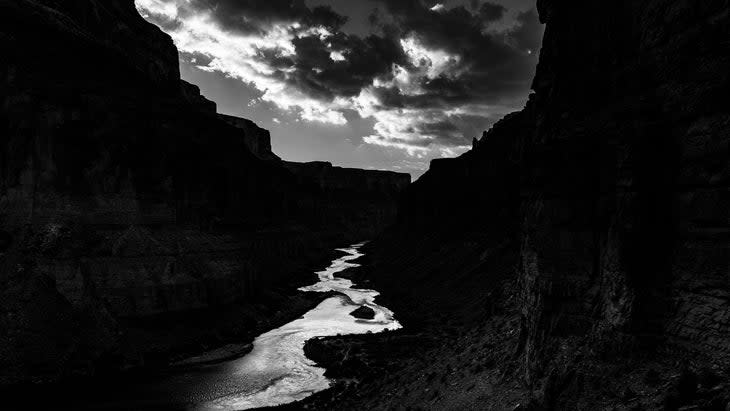
Roughly 900 people have died within Grand Canyon's boundaries since the 1800s, including those in the tragic 1956 plane crash that killed 128. So you can imagine a ghost or two milling around here. Marjorie "Slim" Woodruff is a naturalist who has been hiking in the canyon for 50 years and knows all such stories. She's even had a couple of experiences that she's not sure have logical explanations.
Once, while backpacking deep in the backcountry inside the park, she and a friend heard footsteps outside their tent, even though there were no other hikers around. Another time, after joining a gathering inside the Shrine of the Ages multi-purpose building on the rim, she and a ranger, hanging out alone, heard music playing in another room. But when they looked, they found no one.
"We got out of there," Woodruff says. "I wasn't going to check it out any further."
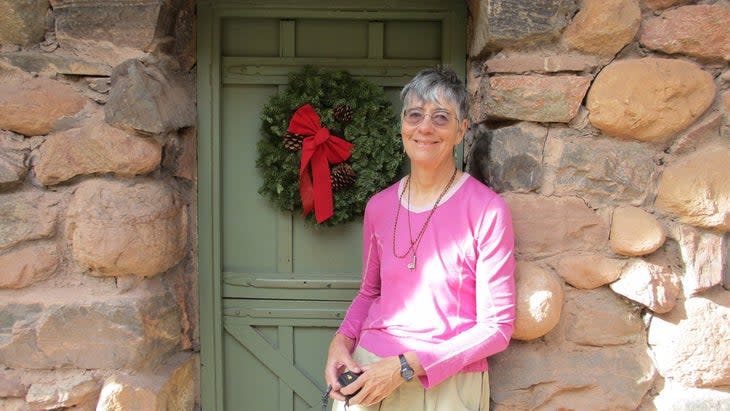
The most prevalent ghost story in the Grand Canyon, according to Arizona Public Radio, is that of a young woman who traveled there with her husband and son shortly after the Grand Canyon Lodge was built in 1928. The husband and son went for a hike on the Transept Trail, which travels from the lodge to the North Rim Campground, while the mother stayed behind. The father and son were caught in a storm, lost their footing, and fell to their deaths along the trail. The mother, dressed in a white dress with blue flowers, searched the trail when they didn't return to the lodge, and eventually, upon learning that her son and husband had perished, ended her own life in the lodge.
Some visitors have reported hearing the sounds of a crying woman along the Transept Trail, while others say they've actually seen her ghost, dressed in a white dress with blue flowers. The Grand Canyon Lodge burned to the ground in 1932, and some witnesses reported seeing a woman's face in the flames, according to Haunted Hikes: Spine Tingling Tales from North America's National Parks.
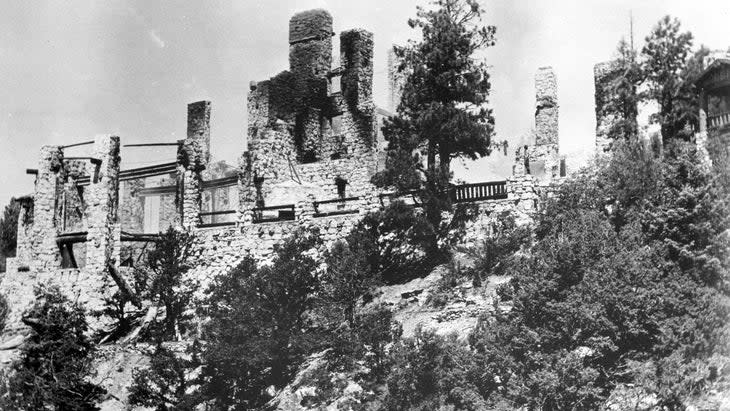
Some science-minded folks are quick to point out that mountain lions make noises that sound like a woman screaming, but these people are no fun and shouldn't be invited to your campfire.
Grand Canyon Spooky Hike: Phantom Ranch
You could hunt for the weeping woman along the Transept Trail, a three-mile jaunt between the Grand Canyon Lodge and the North Rim Campground. Or consider something more adventurous, like looking for the ghost of John Wesley Powell deep in the belly of the canyon at Phantom Ranch. The 101-year-old ranch, built on a plateau just above the river, consists of a handful of cabins and bunkhouses surrounding a larger lodge. Stones from Bright Angel Creek were used as pillars for the buildings, which blend in with the surrounding cottonwoods, and are classic "parkitecture."
But people gathered on this plateau for centuries before the park was established. When John Wesley Powell voyaged through the Grand Canyon by boat in 1869, his expedition rested in this very spot, at the base of stone huts built by ancient Puebloans. Powell was a one-armed Civil War hero whose Grand Canyon expeditions helped fill in the last unknown swaths of the American West. He did not meet his end there, but supposedly his ghost still haunts the Phantom Ranch and nearby Phantom Creek.
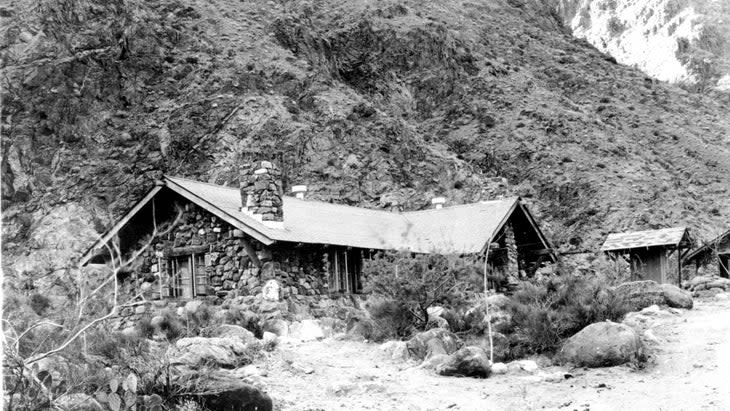
Woodruff knows another ghost story surrounding Phantom Ranch: "Apparently, there's a red-headed woman who comes up to people near the ranch and says, 'I don't know how to get out of here!' and then she vanishes," Woodruff says.
Hike the 7.5-mile descent from the South Rim on the South Kaibab Trail to Phantom Ranch, passing some big overlooks (Ooh Aah Point and Skeleton Point). The dorm rooms at Phantom Ranch are closed through 2023, but the Phantom Ranch Canteen is open from 8 A.M. to 8 P.M. for breakfast, lunch, and dinner. You can't camp at Phantom Ranch, but Bright Angel Campground is .5 miles away.
Great Smoky Mountains, North Carolina and Tennessee
Floating Orbs
The 500,000-acre Great Smoky Mountains National Park was established in 1940, protecting one of the most biodiverse landscapes in the world. The mountains inside the park had been inhabited for centuries, by the native Cherokee and later by farmers and families who lived and worked in small mill towns tucked into the valleys. Thousands of people had to leave their homes when the park was created. The remnants of those communities, from churches to homesites to family cemeteries, can still be found inside the boundaries of the park. And whenever human history intersects with remote wilderness, you have a recipe for scaring...well, me, at least.
One of the coolest phenomenons--lights that defy a definitive scientific explanation--predate the park designation. The "ghost lights" are bright, flashing lights that emanate from the undeveloped ridges of the Thomas Divide Ridge, deep inside the park. You can see them to this day from the Thomas Divide Overlook, at mile marker 464 on the Blue Ridge Parkway, while centuries ago the Cherokee saw the lights and considered them to be spirits of their ancestors.
Scientists have researched the phenomenon, guessing that they're electric charges from the granite deposits in the mountains, or perhaps some sort of biogas release, but there's no definitive answer. Similar mysterious lights can be seen in other spots throughout the world, including the Brown Mountain Lights in nearby Pisgah National Forest.
Steven Reinhold, owner of the guiding service Appalachian Adventure Company, remembers seeing the lights when he was growing up near the Thomas Divide Ridge. "The lights would appear, and sometimes they'd float up into the air, sometimes they'd sink to the valley, sometimes they'd flash...they didn't seem to have any rhyme or reason," Reinhold says. "But there are quite a few different lights in this area. Maybe it's balls of methane gas, or maybe it's ball lightning, or maybe there's something supernatural. Some people believe this whole area's mystical."

The park is also supposedly home to a friendly ghost. Legend has it that before the park was established, a young girl from a local settlement got lost in the woods in the area that later, when dammed, became Lake Fontana. Her father went looking for his daughter but died during the search. According to lore, his spirit appears in the form of a glowing light along the north shore of Lake Fontana, guiding lost hikers back to safety.
That section of the park is home to a number of abandoned communities and cemeteries. I explored it on my visit 15 years ago, even camping near one of the cemeteries and exploring some of the buildings that still stand deep inside the park. I never saw any floating lights, thankfully--given, already, the juxtaposition of historic ruins with gravesites and thick, overgrown forest.
Great Smoky Mountains Spooky Hike: The Noland Creek Trail
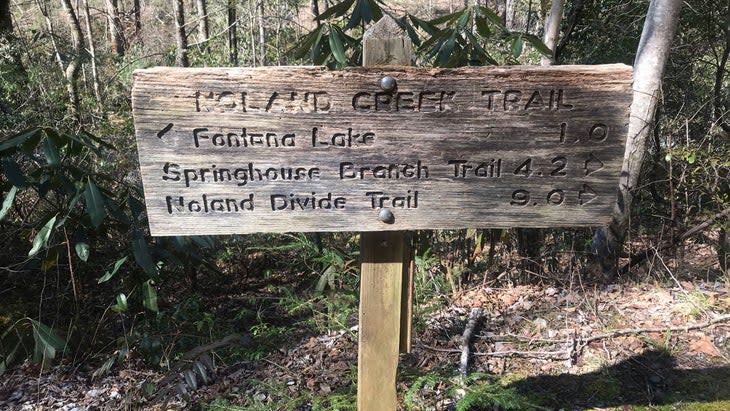
The Noland Creek Trail, where hikers have reported seeing a floating light such as held by the doomed father (Photo: mrssmithslifeunexpected.com)
You can try to see the ghost of the settler yourself by hiking the Noland Creek Trail, where hikers have reported seeing a floating light as held by the long-ago father. Pick up the trail on the north shore of Lake Fontana, at the end of Lakeview Drive, and hike six miles into the park on an old road bed. Up the ante by spending the night at one of the backcountry campsites located off the trail near the abandoned communities and cemeteries ($8 per night, reservations required).
Mammoth Cave National Park, Kentucky
Underground Ghosts
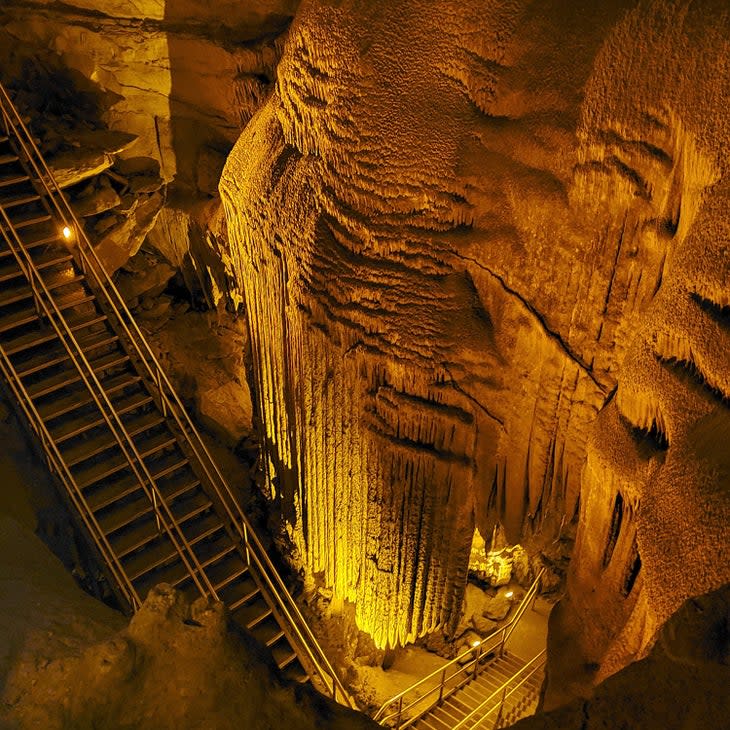
Mammoth Cave is the largest known cave system in the world, with 426 miles of mapped terrain. Artifacts found inside the cave suggest people have been exploring Mammoth for thousands of years, and yet scientists are still discovering new passageways and underground rooms. The cave became a national park in 1941. Before that it was a saltpeter mine during the War of 1812; then it was a privately owned tourist attraction; and it even served a brief stint as a tuberculosis clinic, with patients living underground for months at a time. A couple of the tuberculosis-patients' cabins still stand inside the cave.
Cavers exploring the underground channels in the 1800s and early 1900s found mummified remains of Native Americans that dated back to 445 B.C. Also in the early 1800s, Stephen Bishop, an enslaved guide and explorer, discovered a species of blind albino fish inside the cave. Other scientists have found shark-teeth fossils.
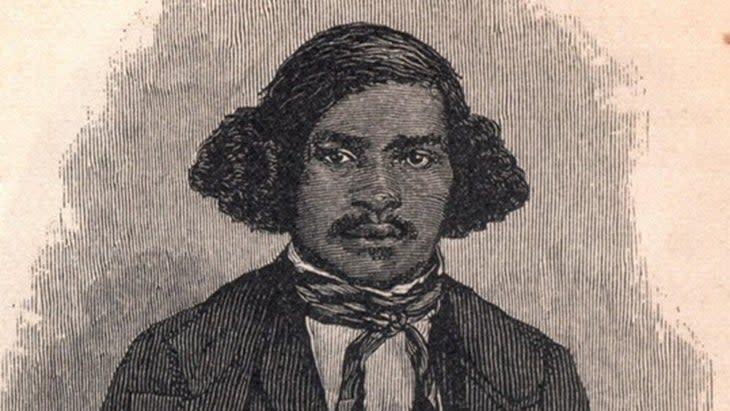
Throughout modern history, visitors have reported ghostly apparitions according to Scary Stories of Mammoth Cave. Some have described the ghost of Floyd Collins, a caver who discovered many of the rooms that visitors now explore, but was trapped by a rock inside the cave in 1925. Collins died after two weeks stuck while other cavers mounted unsuccessful rescue attempts. Some say his ghost keeps cavers from getting lost or injured in the system.
Other visitors have reported hearing coughing from the TB cabins, or being shoved even though no one was near. One ranger wrote in the same book that several people say they have seen a ghostly figure standing on a rock in a room called Chief City, and that the man wore a distinctive hat with a drooping brim that was common among early guides and explorers.
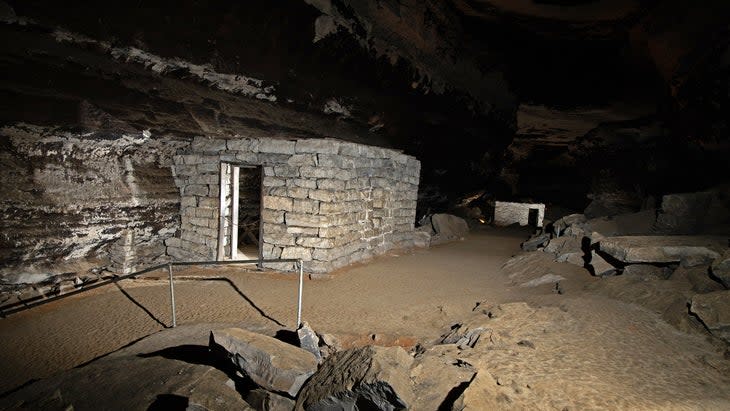
"Other guides have mentioned seeing things, but it's not something we talk about because we like to stick to facts," says Autumn Bennett, who has been guiding tours throughout Mammoth Cave since 2003. She's never experienced anything supernatural herself, but understands how people's imaginations might get the best of them: "Mammoth Cave has been described as grand, gloomy, and peculiar. It's dark and unfamiliar."
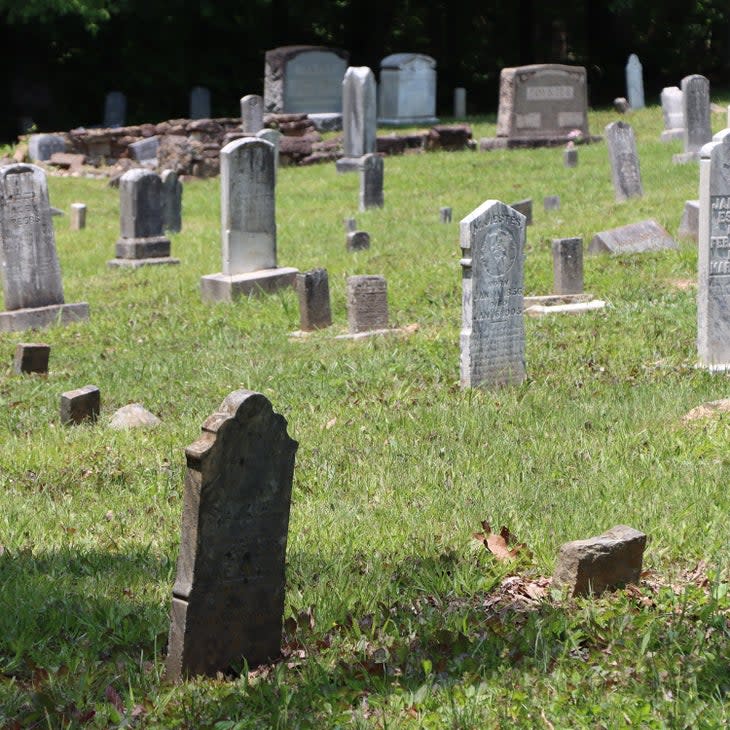
Mammoth Cave Spooky Hike: Violet City Lantern Tour
More than a dozen different ranger-led tours will take you into the belly of the cave, but the Violet City Lantern Tour ($25 per person) is the spookiest because it travels exclusively by lantern light.
"It's a dynamic light," Bennett says. "It moves, follows you, and gives you way more shadows. You really get to understand how easy it is to get carried away with just a lantern light and darkness around you." Not only is the light spooky, but the three-hour tour traverses large rooms where the tuberculosis clinic was housed. You'll even see the two remaining stone huts.
Death Valley National Park, California
Mystery Stones and a Ghost Who Was Hanged Twice
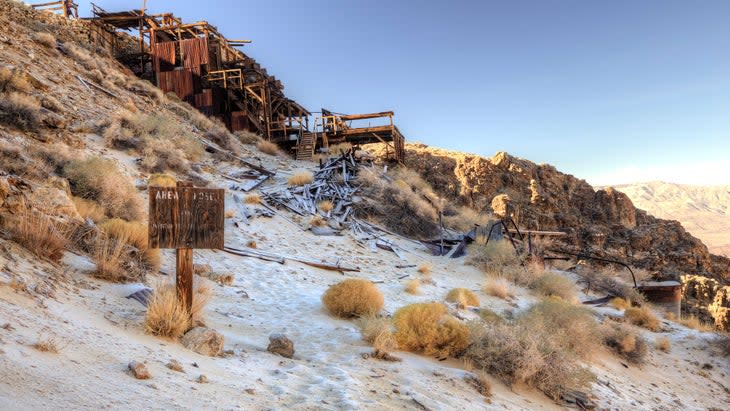
Death Valley is weird. Never mind its name, extreme temperatures, and vast expanses of desert--there are also stones that move on their own. At the Racetrack Playa, a dry lake bed between the Cottonwood and Last Chance ranges, stones large and small slide across the valley floor, leaving trails in the sand. Scientists researched the phenomenon for decades without finding a logical explanation. Ten years ago, while using GPS and weather-monitoring equipment, researchers developed a theory that a combination of ice, sunlight, rain, and high winds creates a scenario where the stones could feasibly be pushed across the firm but muddy surface of the former lake.
Beyond that, the park and surrounding area have more than their share of ghost towns. One is Panamint, which was founded by outlaws who struck silver while hiding out from law enforcement. They gave up their criminal ways, mined silver, and established the town, though it was eventually destroyed by a flash flood in 1876. Ruins of some buildings and mines still stand in the hills.
Another is Skidoo, where in 1908 "Hooch" Simpson was hanged twice--once for killing a banker, and a second time, in a staged event after he died, so that newspaper photographers could document it. According to True West magazine, the townspeople actually dug Hooch up for the second hanging. By most accounts, Hooch was a fairly respectable businessman, but he was convicted of murder after shooting the popular banker and stealing $20.
After the second hanging, the town doctor cut Hooch's head off, apparently looking for signs of syphilis (brain involvement is often an indicator), which might seem to explain his erratic behavior. The headless ghost of Hooch Simpson supposedly still wanders the area that was once Skidoo, looking for his noggin.
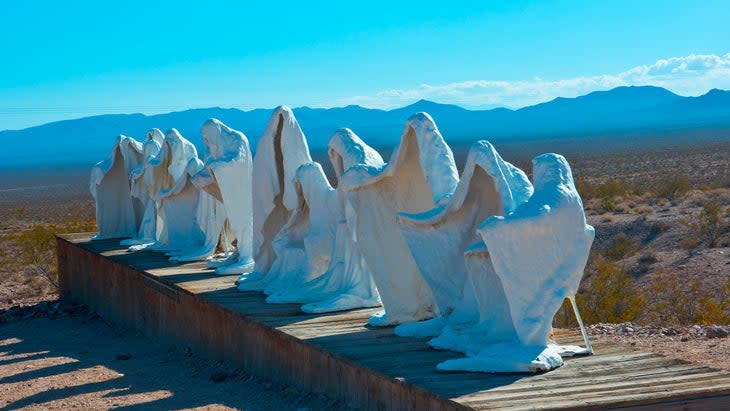
Just outside of the park, on BLM land, are the ruins of the town of Rhyolite, which was home to 10,000 people in its heyday in the early 1900s. You can wander the streets where several buildings still stand. The Goldwell Open Air Museum, next to the skeletal buildings of Rhyolite Ghost Town, is a large-scale sculpture installation created by a group of Belgian artists that's complete with ghostly figures wearing white cloaks.
Not creepy enough? How about the town of Tonopah, where the historic cemetery is filled with victims of a local fire from 1911 and a pneumonia outbreak from 1905, their graves marked with weathered wooden tombstones? Or consider that the ghost of George "Devil" Davis, owner of the local saloon and popular local character who was shot by his wife while he was playing craps, still haunts Tonopah, playing pranks on visitors.
Death Valley Spooky Hike: The Ghost Town of Skidoo
OK, this isn't actually a hike; it's a scenic drive on the well-graded gravel Skidoo Road that you can pick up off the paved Emigrant Canyon Road. But after driving or mountain-biking the eight miles to the town site, you can hike around the area, finding remnants of the town such as broken bottles and tin cans. The remains of the old stamp mill, where ore was crushed to extract gold, stick up on the hillside. There are roughly 1,000 mines in the hills surrounding the ghost town. (Don't go in the mines, and as a matter of practice leave everything as you find it, even if you think it's trash.)
Indiana Dunes National Park, Indiana
Diana of the Dunes
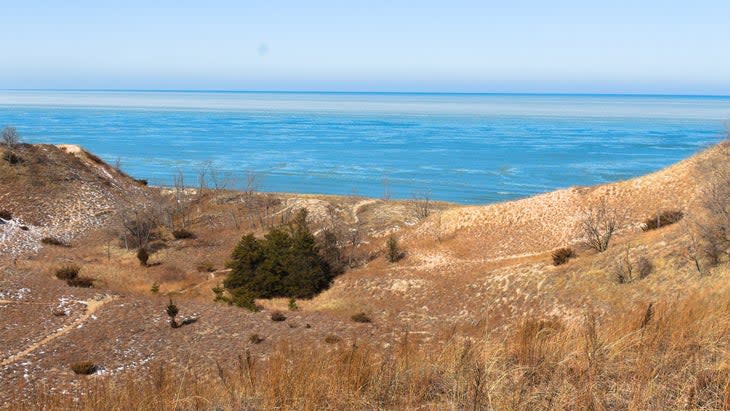
One of the newest units in the national park system, Indiana Dunes protects 15 miles of coastline butting up against Lake Michigan's icy waters. It's a landscape full of beaches, tall dunes, and sandy hiking trails...with a woman ghost who stalks the dunes at night. The place being a Midwestern park, the ghost is by all accounts pretty damn polite.
Alice Mabel Gray, aka Diana of the Dunes, lived by herself in a shack for almost a decade in the early 1900s in the area that is now the national park. Gray had studied at the nearby University of Chicago and worked for the U.S. Naval Observatory after graduating, but chose to eschew modern life for a solitary existence in the dunes, hunting: When she moved to the dunes, she only brought a blanket, cup, knife, and gun. She was also fond of swimming naked in Lake Michigan.
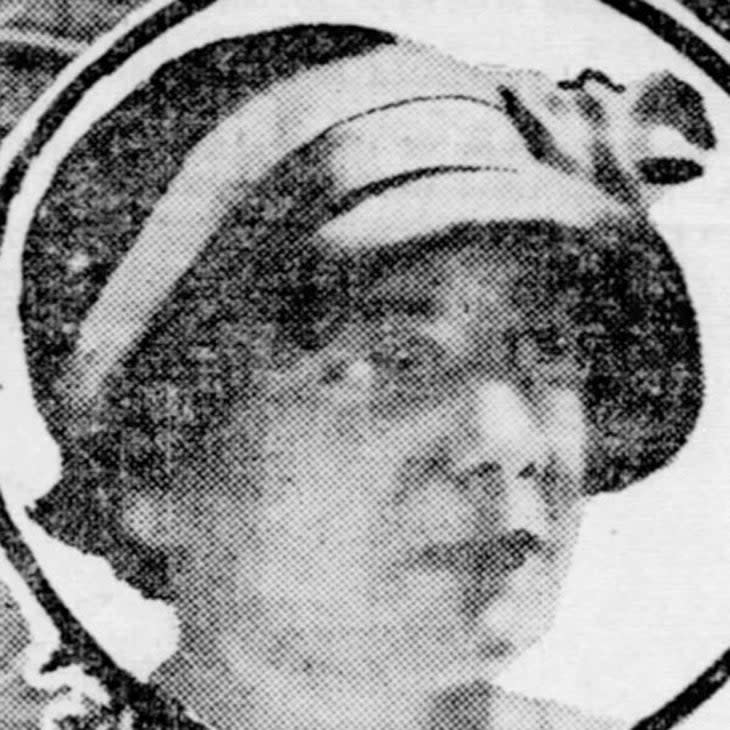
Word got out, and journalists began documenting Gray's alternative lifestyle, dubbing her "Diana of the Dunes," after the Roman goddess of the hunt. Gray was an advocate for protecting the dunes, even writing op-eds in local newspapers. She lived in the dunes throughout her adult life, pairing with a man named Paul Wilson (who by most accounts was a violent individual suspected of murder at one point) and having two children. According to the park service, Gray died in her home within the dunes after giving birth to her second child.
Diana's ghost is less frightening than peculiar; hikers and beachgoers have reported seeing a nude woman running along the sands disappearing into the frothy waters of Lake Michigan. She doesn't bother anyone. She minds her own business, frolicking and enjoying her natural surroundings, much like Gray did.
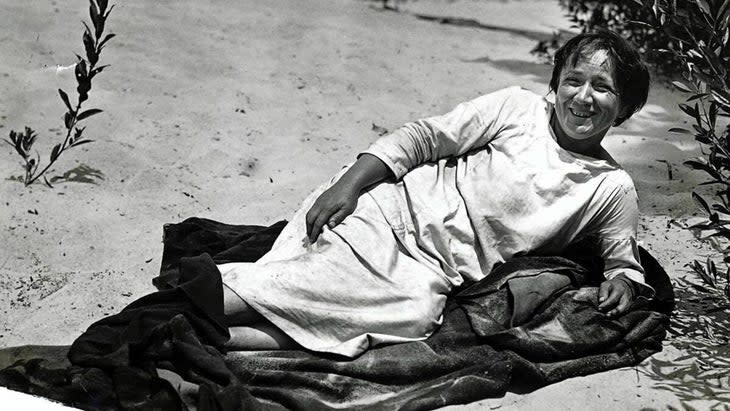
"This is my favorite ghost story from a national park," says Cassie Yahian, of National Parks After Dark. "So often haunted locations are that way because of traumatic, violent events, but Diana's story is quite the opposite. The way she lived her life inspired so many and cemented her place in local legend. Her spirit is said to still roam the dunes that she so cherished in life."
Indiana Dunes Spooky Hike: Diana's Dare
The park has embraced the legend of Alice Mabel Gray and even named a hiking loop after her. Diana's Dare,1.5 miles, takes you from West Beach, on the edge of Lake Michigan, up a series of steps through sandy pine forest to the top of Diana's Dune. From it you can see downtown Chicago, more than 30 miles away. If you want to have the best chance of seeing the ghost of Diana running for the water, I'd say hike the trail at night.
Chickamauga and Chattanooga National Military Park, Tennessee
Civil War Ghosts
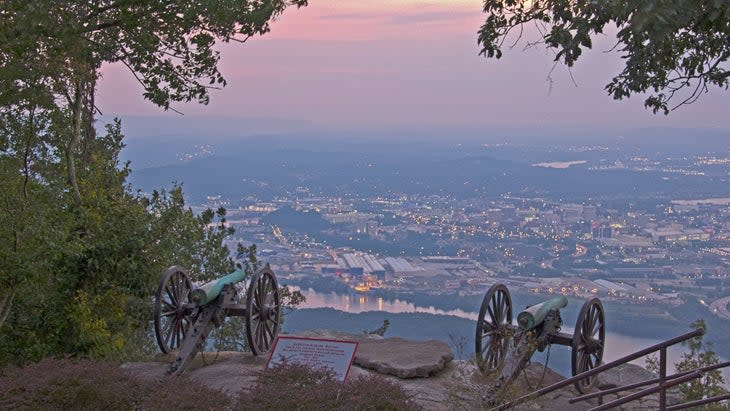
The American South is fraught with historic battlefields from the Civil War. I grew up at the base of Kennesaw Mountain National Battlefield Park and as a kid would find bullets while digging around in my backyard. Chickamauga and Chattanooga National Military Park protects the battlefields surrounding the city of Chattanooga, where one of the war's last key battles was fought, over possession of the city, seen by Abraham Lincoln as the gateway to the deep South. Bloody battles raged throughout the fall of 1863 along the banks of the Tennessee River, in pastoral valleys, and on the flanks of Lookout Mountain, a long, craggy ridge overlooking the city.
As you might imagine with that sort of tumultuous history, Chattanooga and the surrounding landscape are full of ghost stories. Amy Petula, owner of Chattanooga Ghost Tours, knows them all.
"I didn't believe in ghosts when I started these tours," Petula says. "I just thought the stories were a fun way to teach people history. But we've had so many things happen on our tours, I definitely think there's something to the stories now."
Petula says she's personally experienced something inexplicable while touring the Raccoon Mountain Caverns, a 5.5-mile-long cave system at the base of Lookout Mountain. "It was just a few of us, 200 feet underground, in complete darkness, and I saw this faint glowing light behind a girl in our group. It got brighter and started flashing, and then that girl felt something touch her," Petula says. "It wasn't a flashlight. It wasn't another member of our group. Maybe it was a weird cave gas, or something else. I don't know."
Petula says there are stories about a mythical cat that stalks the woods near the battlefields at night, and tales of entire battalions of Confederate soldier ghosts roaming the military park. There's the "Lady in White," a specter wearing a white dress searching for her fiance, a soldier who died in the battle. The stories have gotten so prevalent that park management discourages people from exploring the park after dark in an attempt to dissuade ghost hunters from damaging the historic sites.
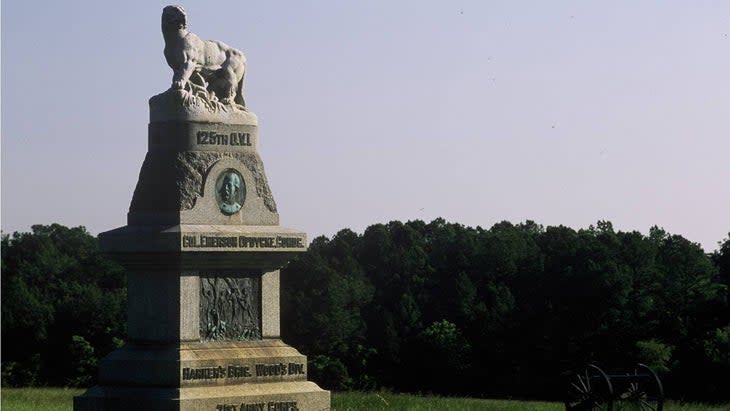
The best-known ghost story is about "Old Green Eyes," a pair of glowing green eyes that harass travelers making their way through the park at night. Sightings date back at least to the Civil War, according to the Rome News Tribune. Some say the glowing eyes belong to the ghost of a soldier who lost his head to cannon fire during the battle of Chickamauga. Other people insist it's a mythical cryptid creature similar to Bigfoot. Or maybe Old Green Eyes is also the ghost cat that stalks the woods. Or maybe he or she is a deer standing in the woods whose eyes only look like they're glowing. Most of the sightings occur near Snodgrass Hill, where some of the most deadly fighting occurred.
Chickamauga Spooky Hike: Snodgrass Cabin
The battlefield has 50 miles of hiking trails to explore, including 30 miles of mountainous terrain on Lookout Mountain. If you want to walk through history, hike through the heart of Chickamauga Battlefield, piecing together a series of short trails to form a big, 14-mile loop around the entire area that takes in gravesites, monuments, old farms, and historic cabins, including Snodgrass Cabin, which was used as a battlefield hospital for both Union and Confederate soldiers. If you're not up for the full 14 miles, you can put together a shorter, two-mile loop around the cabin.The Snodgrass homesite is where the majority of Old Green Eyes sightings occur.
Looking over your shoulder yet?
Graham Averill is Outside magazine's national parks columnist. He loves stories of ghosts and goblins and has even spent a couple of nights in the woods looking for Bigfoot. He'll continue to believe all of these stories are real because life is more fun that way.

For exclusive access to all of our fitness, gear, adventure, and travel stories, plus discounts on trips, events, and gear, sign up for Outside+ today.

